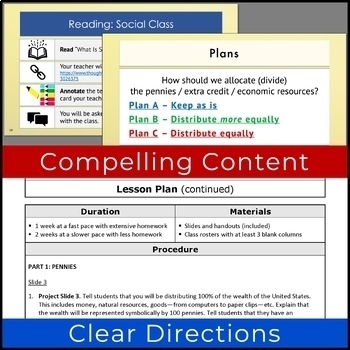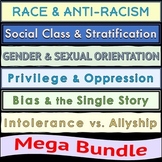Social Stratification Unit + Economic Systems Activity - High School Lessons
- Zip
- Easel Activity
- Easel Assessment
Products in this Bundle (2)
Also included in
- Race, Class, and Gender — together at last! Comprehensive thematic units on Race and Anti-Racism, Gender and Sexual Orientation, and Social Class and Social Stratification with super-engaging activities. These resources will help you integrate complex social justice issues with your content. The intPrice $65.00Original Price $83.50Save $18.50
- Relevant and versatile—provides interactive social justice lessons that help students understand complex topics. Comprehensive thematic units include Race and Anti-Racism, Social Class and Stratification, Gender and Sexual Orientation, Privilege and Oppression, Bias and the Single Story, and IntolerPrice $99.75Original Price $137.50Save $37.75
Description
Throw 100 pennies down and let the learning begin! Use a compelling experiential activity to start an exploration of the elusive “class” in race, class, and gender. This bundle includes a comprehensive unit on SOCIAL CLASS AND SOCIAL STRATIFICATION along with WHO GETS WHAT?, an engaging lesson about economic systems and the distribution of wealth. Includes lesson plans, slides, PDF worksheets, and assessments. The lesson is appropriate for high school classes such as Economics, Sociology, and Ethnic Studies.
The LOW PREP (print and go) SOCIAL CLASS AND SOCIAL STRATIFICATION unit provides lessons organized in a step-by-step manner that helps students comprehend complex concepts. The unit ends with a positive exploration of ways to be proactive through “allyship” and an essay on cooperation vs. competition. The unit topics are 1) Social Structures, 2) Social Stratification, 3) Inequalities, and 4) Social Justice
The SOCIAL CLASS AND SOCIAL STRATIFICATION unit includes:
- A PowerPoint with 61 slides that includes 25 terms and multiple activities
- An extensive guide with easy, step-by-step directions that includes objectives, essential questions, and standards
- An editable terms and definitions handout
- A multiple-choice test, with a key, in editable Word and Easel versions
- A privilege statements survey
- An infographic project on the school-to-prison pipeline with a Research Worksheet handout
- A Close Watching: Video Response Notes handout
- Proactive Reading Annotations cards for readings on “Allyship” and Cooperation vs. Competition
- An Essay Organizer for a 5-Paragraph essay on Competition vs. Cooperation
This WHO GETS WHAT? experiential activity is super-engaging and is remembered by my students years later!
- Students begin by trying to obtain a share of 100 thrown pennies that figuratively represent the wealth of the country and literally represent extra credit. Students are then presented with choices about how the pennies/wealth/extra credit could be divided: as is (unequally), more equally, or equally. The possibilities respectively represent capitalism, socialism, and communism.
- In the next step, students annotate three short texts that summarize the three economic systems. Students then choose what they think is the best economic system (how the country’s resources should be allocated) and write three reasons that support their choice.
- The class then engages in a civil deliberation, which is “the respectful exchange of ideas with the goal of presenting and hearing multiple perspectives in order to understand an issue and answer a question.” After the deliberation, the class votes and the pennies/extra credit are divided accordingly.
- Lastly, students reflect on the content, the process, and their part in the deliberation.
The WHO GETS WHAT? resource includes:
- 32 PowerPoint slides to guide students through the lesson
- An 8-page lesson plan with extensive directions
- A 9-page Civil Deliberation Guide with easy instructions and handouts that take students through the process step-by-step
- The Civil Deliberation Guide handouts include:
- Introduction and Directions
- Part 1: Preparation
- Part 3: Debriefing
- Part 4: Summary
- Part 5: Reflection
- The Civil Deliberation Guide includes graphic organizers that are helpful for differentiation.
Directions in the resources are clear and concise, and they include graphic organizers to help you serve students with special needs. The multiple-choice test is editable to allow you to differentiate the assessment.
*For copyright reasons, the materials in this resource are NOT editable with the exception of specific components that are labeled as editable. You ARE able to insert text boxes and images on slides, rearrange them, and add your own.*
The slides can be imported into Google Slides, Nearpod, or Pear Deck to enhance digital learning and/or to add activities such as discussions and polls.
I also have comprehensive units on:
• Race and Anti-Racism
• Gender and Sexual Orientation
Save BIG and get a bonus with this bundle! Race, Class, & Gender Units - Interactive Lessons, High School, Slides, Digital
If you try my resource, I would love to hear any questions or suggestions that you have. I would also appreciate your writing a review—you’ll receive TPT credits to apply to future purchases! Thank you.
“Social class is probably the single most important variable in society. From womb to tomb, it correlates with almost all other social characteristics.” —James W. Loewen in Lies My Teacher Told Me







